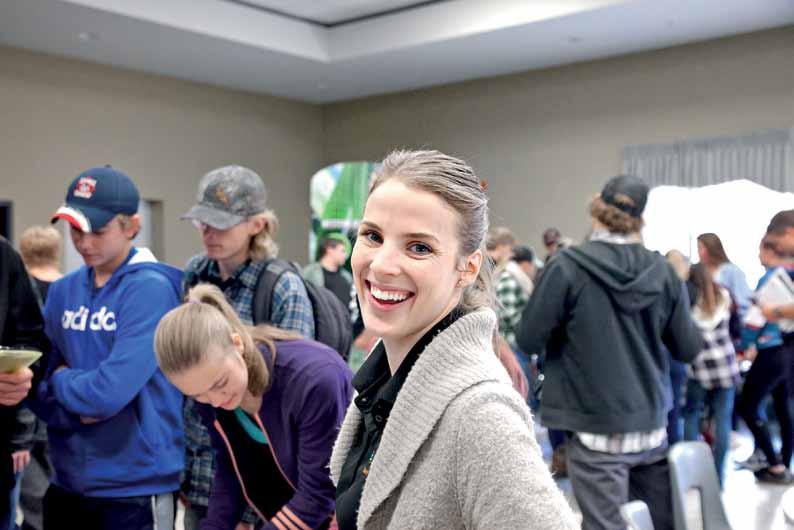
10 minute read
Voice Lessons
voice lessons
Advertisement
By Laura Romanese
From her office in sunny Palo Alto, California, international communications consultant and well-respected author, Jennifer Abrams, spoke with The Register about her work navigating the challenges of multigenerational conversations. Recognized as one of the “21 Women all K-12 Educators Need to Know,” Abrams’ expertise as a “voice coach” — helping others learn how to best use their voice, whether collaborating on a team, presenting to an audience or supervising and guiding employees — has made her an expert in guiding challenging conversations across the spectrum of ages.
R
A
You define yourself as a voice coach. Where did that title come from?
I say voice coach because if you are facilitating a group, there is a specific skill set to that work, and there is a set of skills to being an effective group member too, or in working as a coach. They all require that you use your voice effectively. In my work, I quickly realized that I had the credentials to teach English effectively, but I sure didn’t have the credentials to talk effectively to other adults. It was just never part of my required qualifications list. After many years of research and dedication, I’m able to support leaders like principals and vice-principals by helping them find their voice in school leadership conversations. Specifically, I teach them about having challenging “deep end” conversations and being generationally savvy.
Outside of how to find our voice, do we need to work better at being effective team members? Most educators do want to play in the school sandbox, and do so together, but are we ever taught how to be good communicators as leaders, or good group members with other adults? I know I was definitely taught how to teach my subjects for my grade level, but there is a whole other skill set around how to be an effective group member. Then add generational differences on a team, and discussions around equity, race and so on, and now there is more learning for leaders around how to have conversations that are humane and growth producing.
Why is it important for leaders to consider these differences when talking about challenging conversations with multiple generations? It’s definitely important. Would I say being aware of a person’s generation is any more important than any other part of a person’s identity? Not necessarily. But it is important to recognize that the adults who come in to work with us in our schools and with our kids do come with what we can identify as generational viewpoints. They have generational ways of looking at the idea of work, their expectations around what the employer should be doing to support them and their growth and even what collaboration should look like. Cognitive Coaching would call these frames “filters of perception,” and leaders need to be aware of how these filters play out in what people value and how they communicate. Leaders need to remember to be mindful that while there is a school and a provincial mandate to do different things, your staff does have different perceptions based on their generational category. The work I do, specifically with new teachers, really brings to the forefront these generational differences.
What are the identified generations you currently identify in schools and their defining characteristics in terms of the ways they communicate? Let’s start with the Baby Boomers (Boomer). They were raised post-World War II when the view of the world was perhaps more optimistic. Together they thought they could make a difference for humanity. Characteristically everyone works together: teachers will stay late, some might bake all the cookies, some will organize the social events with a sense of pride for public duty. Typically, it is very much a “how do we make things happen as a team?” approach.
Generation X (Gen Xer) is the group that wants to be in the thick of it, but are characteristically known for wanting to be both efficient and pragmatic. Let’s do the work but let’s be efficient about our time. They may want access to technology, like using a Google Doc for all to see and work on together, but they also may have family and/or other important obligations. So, while they are happy to work together, they don’t always see the need to do everything together in that team approach. Their approach is more: I will get it done on my own time.
Millennials are sometimes referred to as the “me” generation. This group characteristically feels they can be anything they want, and they have the technology and support of those around them readily accessible. Most are very used to having access to things in real time, and expect others to get things to each other pretty quickly – What’s App, WeChat, FaceTime, Instagram – using these tools to communicate with speed. Educators assign them projects to be done in teams, give them clear expectations of what they need to do and set them up to get the work done with support and direction. This group is up for taking charge.
So, what do these differences mean? Well a Gen Xer might say, “That is great, but I need to go home – I will respond to you when the kids go to sleep.” A Boomer might say, “Hey I thought we were working on this together this afternoon,” while a Millennial might say, “I have lots of ideas.
I can text them to you tonight or upload them into our shared folder.” These are all different styles of communication – in person, remotely, expecting 24/7 connections or not being comfortable using technology. I am not saying that there is a right or wrong in these perspectives. But schools, organizations and leaders need to be clear as to what is expected and adaptive in accommodating these differences when they can.
What are your top tips for navigating these generational differences in schools to build better practices for communicating? First, don’t start out having hard conversations. Instead, have more clarifying conversations, that is, ‘clarity before accountability.’ Most leaders feel that once hired, staff members are professionals and they assume that other professionals should just ‘know better.’ So we don’t clarify our expected norms or needs, which without fail angers others. I like to call them “collaboration papercuts.” Those annoying little nitty gritty details like the expectation to arrive on time to a meeting, and the details of what you have to bring. Of course, we think we shouldn’t have to even mention these things to staff, yet these little things irritate the heck out of us when they don’t happen. To avoid this, start out by have a clarifying conversation about specific expectations and how we work together.
Next, remember that generational groups, like our Boomers, need and often want a little more awareness around the use of the word “we.” That means watch your language. Often, we begin conversations with adjectives and adverbs that can inflame a situation. In my own work, I have watched Gen Xer’s say, “I can’t do that,” “I need this” or “that doesn’t work for me.” These statements can easily irritate others because it makes a Gen Xer appear selfish. Ultimately, it’s about being mindful of the relationship with terms like “we,” and being mindful in our conversations of the attitude that may otherwise be personally hurt by the “I” pushback.
Last, remember that Millennials can at times feel unvalued, so watch out for condescension. What this generation wants is to be mutually respected and not to be made to feel like they can’t contribute anything of value to the conversation. If they are present, they are part of the team, so be sure you don’t mistakenly belittle their ideas.
In terms of challenging conversations across generations, always try and start the conversation with a sense of respect. Acknowledge that both parties are colleagues now and will be beyond this interaction. Then watch your language – your use of I or we. Remember that how you end a conversation also matters. Display mutual respect, and reinforce that however difficult the discussion, we are here for student growth and success.
How do we gear professional learning opportunities to educators of different generations? Do they need to be different? Yes and no. When I think about what educators do, where they do it and how they do it, it’s mostly face-to-face. I know, people want Twitter chats and online resources, but there are certain professional
learning opportunities that just don’t lend themselves to those mediums. Who wants their surgeon to have received most of their professional learning from a Twitter chat? Not me! There are times it is more important that we create a sense of community and collaborate face-to-face meetings. Should you be mindful of generational differences? Yes. And you should offer those complimentary options that speak to those identified groups when it appropriately fits. But workshops like the one I conduct about having hard conversations is one that should be done face-to-face.
Would you say it is of value for schools to retain the mix of multi-generational workers? I think it is important to always bring in different perspectives. All organizations need to have different points of view. I know certain schools that unknowingly segregate and isolate the more veteran staff, or aren’t welcoming to new teachers. We need to be mindful to include all voices. This requires us to be both generationally savvy and what is defined as “allocentric” (other focused – opposite to egocentric). We try to make sure all students are heard in our classrooms and we need to do so for all adults as well. You’ve quoted Harriet Lerner a few times in your work, who says, “Our conversations invent us. Through our View the generational breakdown chart from chapter 1 of Abrams’ book: The Multigenerational Workplace: Communicate, Collaborate & Create Community at https:// jenniferabrams.com/wp-content/ uploads/Chapter-1-SummaryGen-Savvy.pdf. speech and our silence, we become smaller or larger selves. Through our speech and our silence, we diminish or enhance the other person, and we narrow or expand the possibilities between us. How we use our voice determines the quality of our relationships, who we are in the world, and what the world can be and might become. Clearly, a lot is at stake here.” What does Harriet’s statement mean to you? I do feel that conversation by conversation, a lot is at stake. Deciding the language we use can cause others to shut down and shut out, or to engage and feel welcomed. The challenge of generational work is about learning how to find our voices while respecting our differences, supporting what really matters in a way that expands and enhances communication in our schools. For principals and vice-principals, effective conversations can ultimately invent and transform the spaces for all staff.
For more information on Jennifer’s work, visit her website to view blog posts, podcasts and subscribe to her newsletter, Voice Lessons. You can also check out her books Having Hard Conversations, The Multigenerational Workplace: Communicate, Collaborate & Create Community and Hard Conversations Unpacked – the Whos, the Whens and the What Ifs and most recently Swimming in the Deep End: Four Foundational Skills for Leading Successful School Initiatives.
lromanese@principals.ca


safety.ophea.net https://agscape.ca/request-ta
Capture it all. Lifetouch Full-page ad. A series of images showing portrait samples for different occasions, such as graduation, student photos...etc.



For 80 plus years Lifetouch has been capturing memories from Kindergarten to graduation. We service over 2200 schools from our 14 Ontario offices and 6000 Canadian schools from Newfoundland to Vancouver Island.
We are proud to partner with Educators in Ontario.













